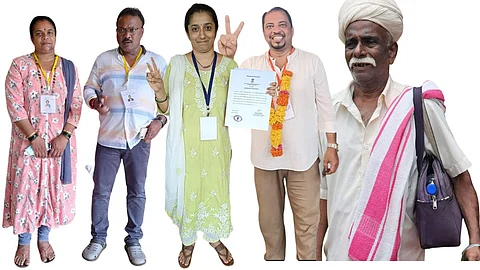

The panchayat elections are done and dusted. In some days, the euphoria surrounding it will die down. Now is the time for action to deliver governance at the grassroots level, and not mete out mere lip service as has been the case over the years. Most panchayats have largely remained as rubber-stamp bodies, hardly able to assert their rights.
It is hoped that the local bodies will now onwards work to create an ambient atmosphere where there will be space for citizens to engage and participate in 'real' grassroots governance. Grassroots in the true spirit means more people's participation to ensure their problems find the right problem-solving platform.
Most of the village panchayats are besieged with garbage problems. Some of the panchayats have no visible system to tackle waste. Those that have one, lack the knowledge or the resources to treat the accumulated waste. Elected leaders must realise that getting rid of the garbage problem will mean cleaner surroundings and clean air for their constituents to breathe.
On the grievance-redressal front, the panchayats will do well if they work toward creating a single-window system so that people in far-flung areas do not have to travel to cities to get their official work done.
Both new and old leaders will have to see that they operate as per the powers vested to them under the Goa Panchayati Raj Act. The government and MLAs, instead of using the panchayat members for their vested interests, should ensure they undertake capacity building for the newly elected leaders to enable them to deliver efficient governance at the grassroots level.
It was heartening to see many women leaders elected this time, but they shouldn't be reduced to mere onlookers or proxies for their male counterparts. This will defeat the very purpose for which the panchayats were constituted.
In the last decade, the Goan political gender landscape has not been able to produce any significant women leaders who have created a mark at the State level. The Panchayati raj was introduced to create a strong space for women, but, in Goa, the scorecard on this front is still not very good.
Also, the panchayats will have to take control of the land and development in their villages. In Goa, land has become the most important resource, with the builders' mafia eyeing some of the prime areas for commercial and other purposes. Here, the panchayats will have to stand as a watchdog.
However, on this front, the local bodies don't infuse much hope in people -- the reason being the recent cases and subsequent arrests in the land grab fiasco. The land mafia has had a free run and it is not without the collusion of some of the village panchayats, where land-grab cases have come to light.
These days, the country is in the middle of the 'Har Ghar Tiranga' campaign which drives home the message that the tricolour is a symbol of pride for every Indian. In the same vein, when the Panchayati Raj System was established, it was meant to take home the message of true governance to India's villages, but has remained a mere administrative manual.
It is time, at least in our tiny Goa, the panchayats show the way and start working as true models of governance for every citizen to feel proud to be a part of them.